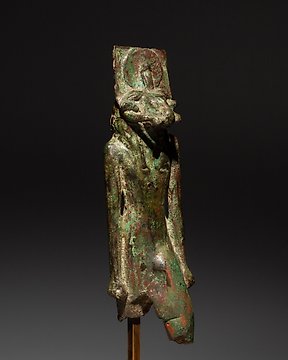
Ancient Egyptian Bronze Sculpture of the deity Khnum. Late Period, 664 - 332 BC. 13 cm Height.
No. 83408285

No. 83408285

Sculpture of the God Bes.
Ancient Egypt, Ptolemaic or Roman Period; 332 BC-1st century AD.
Bronze.
9.5 cm height, 12.5 cm with the stand.
CONDITION: The lower area of the sculpture is missing at knee level.
PROVENANCE: Private collection, Paris, France. 1970.
DOCUMENTS: Provided of a certificate of authenticity and export license by the Ministry of Culture from Spain.
DESCRIPTION:
Bes, together with his feminine counterpart Beset, is an ancient Egyptian deity worshipped as a protector of households and, in particular, of mothers, children, and childbirth. Bes later came to be regarded as the defender of everything good and the enemy of all that is bad. Bes may have been a Middle Kingdom import from Nubia or Somalia, and his cult did not become widespread until the beginning of the New Kingdom.
Worship of Bes spread as far north as the area of Syria and as far west as the Balearic Islands (Ibiza) in Spain, and later into the Roman and Achaemenid Empires.
Bes was a household protector, becoming responsible – throughout ancient Egyptian history – for such varied tasks as killing snakes, fighting off evil spirits, watching after children, and aiding women in labour by fighting off evil spirits, and thus present with Taweret at births.
Images of the deity, quite different from those of the other gods, were kept in homes. Normally Egyptian gods were shown in profile, but instead Bes appeared in full face portrait, ithyphallic, and sometimes in a soldier's tunic, so as to appear ready to launch an attack on any approaching evil. He scared away demons from houses, so his statue was put up as a protector. Since he drove off evil, Bes also came to symbolize the good things in life – music, dance, and sexual pleasure. In the New Kingdom, tattoos of Bes could be found on the thighs of dancers, musicians and servant girls. Many instances of Bes masks and costumes from the New Kingdom and later have been uncovered. These show considerable wear, thought to be too great for occasional use at festivals, and are therefore thought to have been used by professional performers, or given out for rent.
Later, in the Ptolemaic period of Egyptian history, chambers were constructed, painted with images of Bes and his wife Beset, thought by Egyptologists to have been for the purpose of curing fertility problems or general healing rituals.
Notes:
- The piece includes authenticity certificate.
- The piece includes Spanish Export License.
- The seller guarantees that he acquired this piece according to all national and international laws related to the ownership of cultural property. Provenance statement seen by Catawiki.
#ancientcivilisations
How to buy on Catawiki
1. Discover something special
2. Place the top bid
3. Make a secure payment